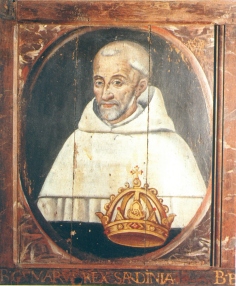
Pisa is a city and comune in Tuscany, central Italy, straddling the Arno just before it empties into the Ligurian Sea. It is the capital city of the Province of Pisa. Although Pisa is known worldwide for its leaning tower, the city of over 91,104 residents contains more than 20 other historic churches, several medieval palaces, and various bridges across the Arno. Much of the city's architecture was financed from its history as one of the Italian maritime republics.

Pope Gelasius II, born Giovanni Caetani or Giovanni da Gaeta, was Pope from 24 January 1118 to his death in 1119. A monk of Monte Cassino and chancellor of Pope Paschal II, Caetani was unanimously elected to succeed him. In doing so he also succeeded to the conflicts with Emperor Henry V over investiture. Gelasius spent a good part of his brief papacy in exile.

Ugolino della Gherardesca, Count of Donoratico, was an Italian nobleman, politician and naval commander. He was frequently accused of treason and features prominently in Dante's Divine Comedy.

The Battle of Meloria was fought near the islet of Meloria in the Ligurian Sea on 5 and 6 August 1284 between the fleets of the Republics of Genoa and Pisa as part of the Genoese-Pisan War. The victory of Genoa and the destruction of the Pisan fleet marked the decline of the Republic of Pisa.

The Republic of Pisa was a de facto independent state centered on the Tuscan city of Pisa during the late 10th and 11th centuries. It rose to become an economic powerhouse, a commercial center whose merchants dominated Mediterranean and Italian trade for a century before being surpassed and superseded by the Republic of Genoa. The power of Pisa as a mighty maritime nation began to grow and reached its apex in the 11th century when it acquired traditional fame as one of the four main historical Maritime Republics of Italy.

William I, regnal name Salusio IV, was the Giudice of Cagliari, or high Judge, from 1188 to his death. His descendents and those of his immediate competitors intermarried to form the backbone of the Italian Aristocracy, and ultimately their descendents in the Medici clan are precursors to, and definers of later royalty and claims thereto.

Gonario II was the giudice of Logudoro from the death of his father to his own abdication in 1154. He was a son of Constantine I and Marcusa de Gunale. He was born between 1113 and 1114 according to later sources and the Camaldolese church of S. Trinità di Saccargia was founded in his name by his parents on 16 December 1112, though it wasn't consecrated until 5 October 1116.

The Judicate of Cagliari was one of the four Sardinian judicates of the Middle Ages, kingdoms of Byzantine origins.
Constantine II, called de Martis, was the giudice of Logudoro. He succeeded to the giudicato sometime between 1181 and 1191. He was the son of Barisone II and Preziosa de Orrubu. His father associated him with the government in 1170 and abdicated the throne to him around 1186. His reign was generally characterised by contemporary chroniclers as "tyrannical."

The Judicate of Gallura was one of four Sardinian judicates in the Middle Ages. These were independent states whose rulers bore the title iudex, judge. Gallura, a name which comes from gallus, meaning rooster (cock), was subdivided into ten curatoriae governed by curatores under the judge. In the 13th century, the arms of Gallura contained a rooster.

Saint Rainerius is the patron saint of Pisa and of travellers. His feast day is June 17. His name may also be spelled Raynerius, Rainerius, Rainier, Raineri, Rainieri, Ranieri, Raniero, or Regnier.

Benedetta was the daughter and heiress of William I of Cagliari and Adelasia, daughter of Moroello Malaspina. She succeeded her father in January or February 1214.
Ugo da Parlascio Ebriaco was a leading citizen in the Republic of Pisa in the early twelfth century.
William II Salusio V was the Judge of Cagliari from 1232 to his death. His Christian name was William, but his regnal name was Salusio, based on ancient Cagliaritan traditions which alternated their rulers between the forenames Torchitorio and Salusio. He would have been called Salusio in official documents, though he is known historically as William, after his grandfather, William I.

The Archdiocese of Pisa is a metropolitan see of the Catholic Church in Italy. It was founded in the 4th century and elevated to the dignity of an archdiocese on 21 April 1092 by Pope Urban II. Its mother church is the cathedral in the Piazza del Duomo. Since 2008 the Archbishop of Pisa has been Giovanni Paolo Benotto.
Torchitorio II, also known by his birth name as Marianus II and surnamed de Unali, was the Judge of Cagliari from circa 1102 to his death, but initially with opposition.

The history of Corsica in the medieval period begins with the collapse of the Western Roman Empire and the invasions of various Germanic peoples in the fifth century AD, and ends with the complete subjection of the island to the authority of the Bank of San Giorgio in 1511.
Rabodo was the imperial vicar and marquis of Tuscany from 1116 until his death in battle in 1119. A German count, he was appointed by the Emperor Henry V after the death of the Marchioness Matilda of Tuscany (1115) in order to break the practice of hereditary succession in the Tuscan marquisate. He was a much weaker ruler than his predecessor, unable to dominate the many disparate forces opposed to direct imperial rule. This weakness is often associated with the rise of autonomous city government in Florence. In a document of 11 September 1116, Rabodo is called "marquis of Tuscany owing to imperial largesse", but in one dated to 1119 he is said to rule "by God's grace", using the same formula used by Matilda.













